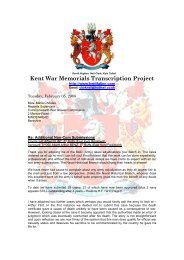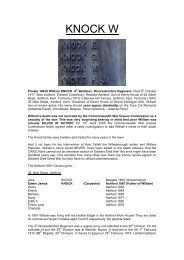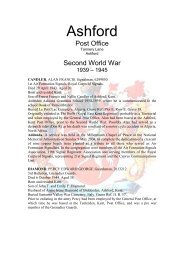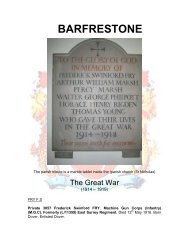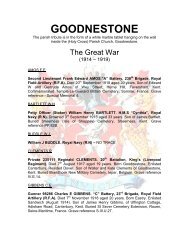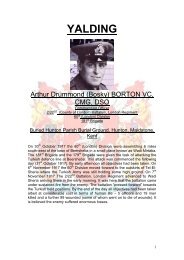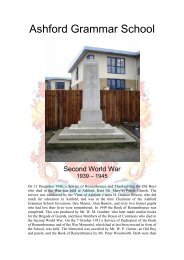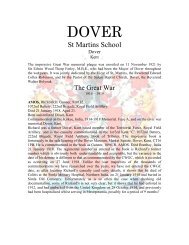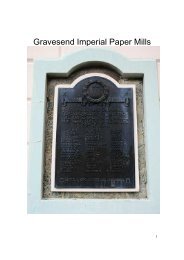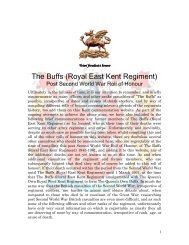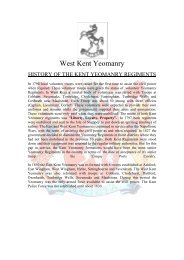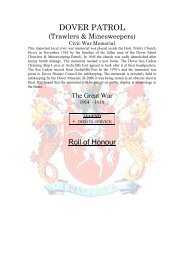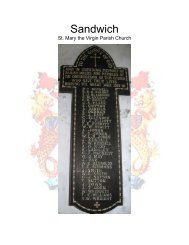HOLY TRINITY HALL MEMORIAL 1914-18 - Kent Fallen
HOLY TRINITY HALL MEMORIAL 1914-18 - Kent Fallen
HOLY TRINITY HALL MEMORIAL 1914-18 - Kent Fallen
Create successful ePaper yourself
Turn your PDF publications into a flip-book with our unique Google optimized e-Paper software.
Evans and R.L.F Forster, Lieutenant’s K.L James, Grant, King and Wills posted as<br />
missing of whom the first five were found to have been killed; 25 other ranks were also<br />
killed, plus 128 wounded and in addition to which 207 were initially reported as being<br />
missing, but ultimately many were later found to have lost their lives during and resulting<br />
from the attack of 2 and 3 May 1917. About 0200 hours on 4 May the remnant was<br />
relieved and got back, on the following day what remained of the battalion was<br />
reorganized into two companies each of which consisted of only two platoons, No 1<br />
Company had Second Lieutenant Stevens in command, with Second Lieutenant’s Sowter,<br />
Seago and Sankey under him; No 2 Company was commanded by Captain Carter,<br />
assisted by the intrepid Second Lieutenant’s Gunther and Cockeram. Following a later<br />
debriefing meeting to see if lessons could be learned from the attack of 3/4 May by the<br />
battalion a few things became obvious, the main points raised being that it was a pity that<br />
“the ground was quite unknown to the battalion which had not held the same position<br />
previously, and that the orders to attack came so late that there was no time for systematic<br />
reconnaissance,” also that the early part of the engagement had been undertaken in the<br />
dark. Those surviving members of the battalion who were not in the hands of the medical<br />
teams left Monchy-le-Preux and were then rested in nearby Arras for a mere 48 hours and<br />
then underwent a further ten days in the trenches before being relieved on 17 May when<br />
the battalion moved to Duisans. Both Second Lieutenant’s Cockeram and Gunther<br />
received the Military Cross for their gallant conduct on 3/4 May 1917, but it is sad to<br />
have to add that Norman Gunther, who was an attached officer of the Royal East <strong>Kent</strong><br />
Yeomanry was killed shortly afterwards, with the cruel irony of his death occurring<br />
within half a mile of Keeling Copse when gallantly defending a trench the Germans were<br />
attacking, although not strictly speaking a “Buff,” we have included a commemoration to<br />
the brave 19 year old subaltern on this roll of honour alongside the 396 members of the<br />
regiment, who have no known grave that are commemorated on the Arras Memorial,<br />
some of whom died with him. Second Lieutenant Cockeram MC later transferred to the<br />
Royal Flying Corps as an Observer, on one occasion whilst a member of 48 Squadron<br />
based at Bertangles, he and his pilot Captain H.C Sootheran flying a Bristol BF2b shot<br />
down an enemy aircraft, and despite numerous encounters with enemy aircraft and being<br />
subjected on numerous occasions to anti-aircraft fire both RFC officers thankfully<br />
survived the war.<br />
COOPER, ALBERT EDWARD. Rifleman, A/200306.<br />
11th (Service) Battalion, King’s Royal Rifle Corps.<br />
Died 13 August 1917. Aged 21.<br />
Born and resided Dover, <strong>Kent</strong>. Enlisted Canterbury, <strong>Kent</strong>.<br />
Son of Frank and Matilda Ann Cooper of 8, Limekiln Street, Dover, <strong>Kent</strong>.<br />
Commemorated on the Menin Gate, (Ypres) Ieper, West-Vlaanderen, Belgium.<br />
Panel 51, and the Dover, <strong>Kent</strong> civic war memorial.



